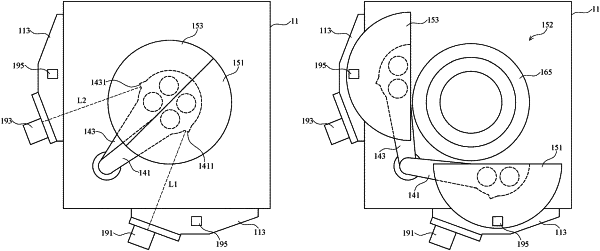| CPC H01J 37/3447 (2013.01) [C23C 14/34 (2013.01); C23C 14/54 (2013.01); H01J 37/32651 (2013.01); H01J 37/3441 (2013.01); C23C 16/4405 (2013.01); H01J 2237/332 (2013.01)] | 14 Claims |

|
1. A thin-film-deposition equipment, comprising:
a reaction chamber comprising a containing space, with a target material disposed on a ceiling surface of the reaction chamber;
a carrier disposed within the containing space for carrying at least one substrate thereon, and the target material facing the carrier; and
a shielding mechanism comprising:
a first-shield member that is disposed within the containing space;
a second-shield member that is disposed within the containing space, wherein each of the first-shield member and the second-shield member is formed as a half-round plate, and both of the first-shield member and the second-shield member are formed with at least one cavity facing the carrier to reduce weights of the first-shield member and the second-shield member, wherein the first-shield member and the second-shield member are arranged on a same plane; and
a first-connecting arm for carrying the first-shield member; and
a second-connecting arm for carrying the second-shield member;
at least one driver that comprises:
a shaft seal which interconnects the first-shield member and the second-shield member; wherein the shaft seal comprises an outer tube and a main shaft contained within the outer tube;
at least one motor which is connected to the shaft seal and which respectively drives and swings the first-shield member and the second-shield member in opposite directions synchronously to switch between an open state and a shielding state via the shaft seal;
wherein in the open state, the first-shield member and the second-shield member swing away from each other to have an open space therebetween to expose the carrier to the target material; and
wherein in the shielding state, the first-shield member and the second-shield member approach each other to form a round plate as a whole shield to shield the carrier to cover the carrier, wherein the first shield member and the second shield member operating in the shielding state are not in direct contact to form a distance therebetween in the same plane that the first shield member and the second shield member are arranged on, and the distance is less than 1 mm;
wherein the main shaft is connected to the first-shield member via the first-connecting arm, the outer tube is connected to the second-shield member via the second-connecting arm, and the at least one motor drives the main shaft and the outer tube to rotate to respectively swing the first-shield member and the second-shield member in the opposite directions synchronously;
wherein the first-connecting arm includes a first protrusion with a first-reflective surface thereon perpendicular to an extending direction of the first-connecting arm, the second-connecting arm includes a second protrusion with a second-reflective surface thereon perpendicular to an extending direction of the second-connecting arm;
wherein the thin-film-deposition equipment further comprises:
a first-distance sensor disposed on side of the first-shield member, wherein the first-distance sensor emits and projects a first-optical beam onto the first-reflective surface when the first-shield member is operated in the shielding state; and
a second-distance sensor disposed on side of the second-shield member, wherein the second-distance sensor emits and projects a second-optical beam onto the second-reflective surface when the second-shield member is operated in the shielding state.
|